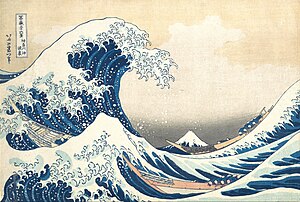
Back Impressió xilogràfica del Japó Catalan Japonský dřevořez Czech Impresión xilográfica en Japón Spanish Impression sur bois au Japon French Cetak balok kayu di Jepang ID Xilografia giapponese Italian 木版画 Japanese Ksilografinė spauda Japonijoje Lithuanian വുഡ്ബ്ലോക്ക് പ്രിൻറിംഗ് ഇൻ ജപ്പാൻ Malayalam Xilogravura no Japão Portuguese

Metropolitan Museum of Art
Woodblock printing in Japan (木版画, mokuhanga) is a technique best known for its use in the ukiyo-e[1] artistic genre of single sheets, but it was also used for printing books in the same period. Invented in China during the Tang Dynasty, woodblock printing was widely adopted in Japan during the Edo period (1603–1868). It is similar to woodcut in Western printmaking in some regards, but was widely used for text as well as images. The Japanese mokuhanga technique differs in that it uses water-based inks—as opposed to Western woodcut, which typically uses oil-based inks. The Japanese water-based inks provide a wide range of vivid colors, glazes, and transparency.
- ^ Asian Art, Department of. "Art of the Pleasure Quarters and the Ukiyo-e Style". Metropolitan Museum of Art. Metropolitan Museum of Art. Archived from the original on 19 October 2023. Retrieved 14 September 2023.
© MMXXIII Rich X Search. We shall prevail. All rights reserved. Rich X Search